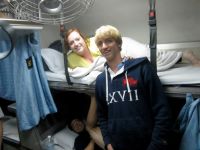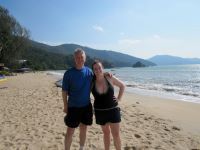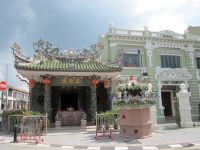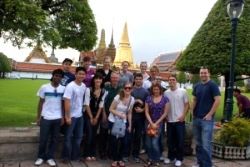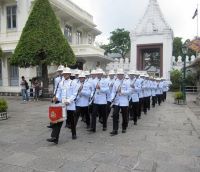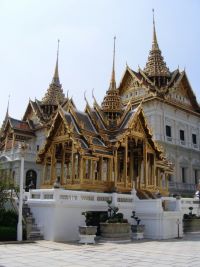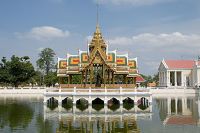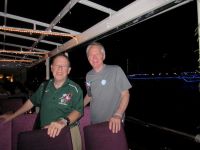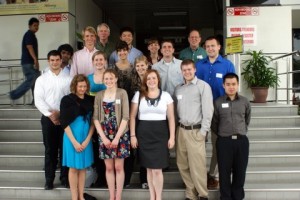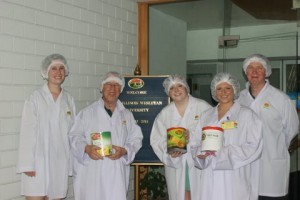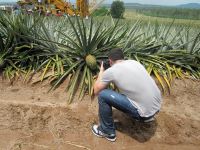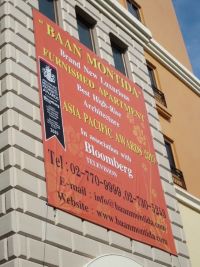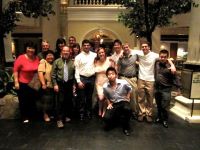Another wonderful day that began with the “other” weather in Penang–we had a severe thunderstorm last night, providing us with hot, humid, and rainy weather, rather than the hot and humid that is the standard fare. That put an end to the original plan I had, which was to bike in the morning–that, and the sad fact that as we get closer to the equator, daylight gets shorter; it wasn’t light until around 7, and by then, traffic would make bicycling too much an adventure.
The rain stopped before we left, and the “regular” hot and humid weather returned–which, in turn, made our visit to the Dell factory a challenge, because the visitor guide said “long pants, real shoes, real shirt.” When we got to Dell, as it turned out, I recognized our three hosts from my last trip. Two were in HR, and they gave us an overview of the company. Dell is a 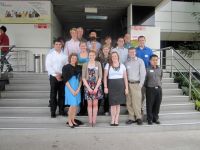 Fortune 40 company, with headquarters in Austin, Texas (the mother church), somewhere in Europe, and Asia Pacific, in Singapore. The factory is under the Asia Pacific region, and now supplies Asia Pacific with servers and desktop computers. Last time I was there, the Penang factory was the major assembler of laptops for the American market; in fact (I checked when I got home), mine was made there–and I received it less than a week after I placed the order. I remembered that the plant managers last time had talked about an imminent change, because stockholder pressure was being exerted to outsource manufacturing. Dell was one of the few computer companies to manufacture its own machines.
Fortune 40 company, with headquarters in Austin, Texas (the mother church), somewhere in Europe, and Asia Pacific, in Singapore. The factory is under the Asia Pacific region, and now supplies Asia Pacific with servers and desktop computers. Last time I was there, the Penang factory was the major assembler of laptops for the American market; in fact (I checked when I got home), mine was made there–and I received it less than a week after I placed the order. I remembered that the plant managers last time had talked about an imminent change, because stockholder pressure was being exerted to outsource manufacturing. Dell was one of the few computer companies to manufacture its own machines.
Last year, the company switched the production to Xiamen, China, and relegated the Penang facility to Asia Pacific. One of the results was the reduction of the staff from almost 4,000 employees to around 600. When I asked about managing a multiethnic work force, they told me that by law they had to hire at least 30% Muslims, and had an extra long Friday lunch hour, which is one of the times of day Muslims pray (and Friday is the holy day). Starting workers get 600 ringgit’s a month for a 6-day week (Monday is the off day), which is about 2,400 U.S. dollars. As I mentioned, the average income in the country is around 14,000. The visit once again confirmed my mantra over the past few years that “what was, isn’t, and what is, might not be.” Even in Asia.
We spent the rest of the day visiting and viewing in Penang, a city of around 1 million people that has made a special point of being an attractive free enterprise zone for multinationals–high tech companies such as Western Digital, Intel, Hewlett Packard, and Sony, which we saw on the way to the airport. The managers praised the well-disciplined work force, and the HR manager told me he was in charge of helping employees become better prepared for the future. That was the message of his presentation, and the vision/mission statement of the parent company.
They also told me that the plant was already doing some contract manufacturing for other brands, and had a plan to continue to seek ways to use its assembling skills, not to mention the space that once housed 4,000 employees.

The rest of the day was spent not in the present/future, but in the past–the 250-or-so-year-old history of the once-British colony. Mr. Light helped the sultan of Perak break free of his payments to the King of Siam in the 1780s in return for the Sultan’s giving the British East India Company the rights to the island of Penang. Thus began the gradual British establishment of Malaysia–Malacca came during the Napoleonic wars (to keep it out of the hands of the French, the British conquered it from the Dutch; after the wars, they exchanged it for Bencoolen), and later added Singapore. When the East India Company could not protect Penang, it called in the British army, which established a garrison at Fort Cornwallis.
The main visits demonstrated the Chinese impact (which still exists) on the city. One was the restored (for $7 million) house of the “capitan” of the Chinese community, sort of the political administrator who reported to the 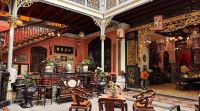 British (there was also a Muslim capitan and an Indian one, but the Chinese were the most numerous and the ones most responsible for
British (there was also a Muslim capitan and an Indian one, but the Chinese were the most numerous and the ones most responsible for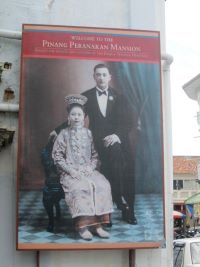 the wealth of the colony). He married a Malay woman, and the house is now a museum to the Boba/Nonya culture that emerged. One thing I noticed was that in the shoe collection, there were no shoes for “bound feet.” Back in history, one of the Chinese emperors liked women with small feet, and thereafter, non-peasant women had their feet bones broken and bound to make “lily” feet, a practice that did not end until the 20th century, but the Malay wives had regular feet.
the wealth of the colony). He married a Malay woman, and the house is now a museum to the Boba/Nonya culture that emerged. One thing I noticed was that in the shoe collection, there were no shoes for “bound feet.” Back in history, one of the Chinese emperors liked women with small feet, and thereafter, non-peasant women had their feet bones broken and bound to make “lily” feet, a practice that did not end until the 20th century, but the Malay wives had regular feet.
The second tour was of a “clan house” for the Khoo family. You might have seen it in The King and I, shot in Malaysia because the Thais refused to allow the film, which is still banned in Thailand, from being shot there. The clan, from Fujian (Hokkien in the Fujian dialect), established a welfare/education 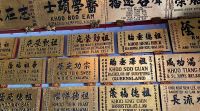
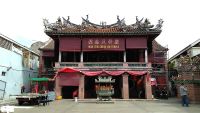 society for ancestor worship and fellowship. One fascinating feature (to me) was the hall of scholars, where the Khoos are listed by generations (now on the 43rd generation) together with their accomplishments, mostly academic. Schools included the Middle Temple in London for barristers, as well as commonwealth schools in England, Australia, and Malaysia–the emphasis on education is soooo Confucian.
society for ancestor worship and fellowship. One fascinating feature (to me) was the hall of scholars, where the Khoos are listed by generations (now on the 43rd generation) together with their accomplishments, mostly academic. Schools included the Middle Temple in London for barristers, as well as commonwealth schools in England, Australia, and Malaysia–the emphasis on education is soooo Confucian.
I still marvel in driving around the heritage district at the old colonial bungalows. There are streets full of two-story buildings, with the second 
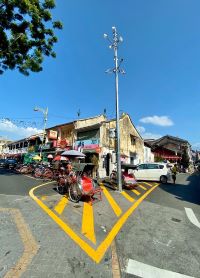 floor built over the street, shading against heat and rain. Happily for me, in the old district, residents cannot tear anything down, which means the clocktower to Victoria, the old government buildings, and the homes of the rich and famous remain.
floor built over the street, shading against heat and rain. Happily for me, in the old district, residents cannot tear anything down, which means the clocktower to Victoria, the old government buildings, and the homes of the rich and famous remain.
It’s almost as good as going to a museum for me, and you know how much I love museums!
We are about to depart for Kuala Lumpur, so I hope we will have adventures there that I can share in the next few days. I’ve been to Penang maybe five times–not often enough, and as you can tell from the blog, never long enough.
